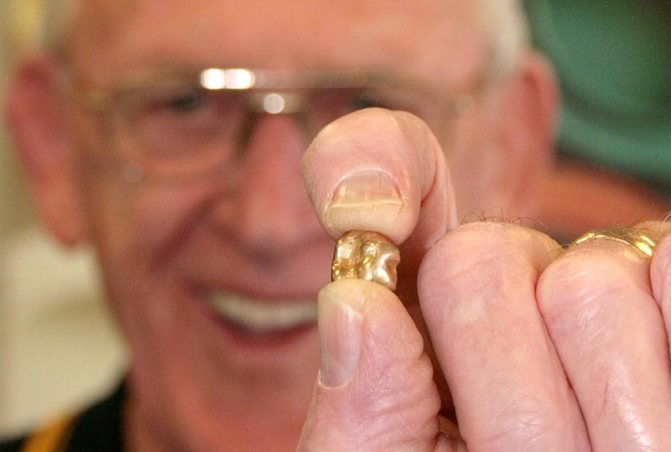Features of gold crowns: what they are, how to install and remove them
Article navigation
- Use of gold in dentistry
- Features of pure gold prostheses
- Types of gold dental crowns
- Advantages and disadvantages of prostheses
- Indications for installation of crowns made of precious metals
- Who should not get gold prostheses?
- Features of making prostheses
- How does the installation work?
- Adjustment period: main problems
- How to remove a gold crown
- Who gets the crown after removal?
- Is it possible to clean the crown from glue residues?
- Features of product care
- How long can the product be used?
Question for a specialist
Until recently, a smile with a golden sheen was considered an indicator of the owner’s presentability and wealth. Gold crowns, due to the safety and softness of the material, were extremely popular, and the durability of the products is still demonstrated by representatives of the older generation. Meanwhile, modern materials used in dental prosthetics better meet aesthetic requirements. Why do many people prefer gold, what are the features of such products, how to clean gold crowns from residues - more on this and much more later in the article.
Advantages and disadvantages
Advantages of false teeth made of gold:
- High biocompatibility with tissues of the human body. Gold does not cause the development of allergic reactions, is not toxic and does not provoke discoloration of the gums and enamel of adjacent teeth.
- Under the influence of oxidizing agents, gold crowns do not corrode and do not oxidize in the mouth. Therefore, they do not change the taste of saliva and cannot cause the development of an unpleasant odor.
- The sufficient softness of the metal makes it possible to produce crowns that exactly match the tooth being prosthetized and fit tightly to the supporting dense tissues.
- Gold has a high strength coefficient, does not chip and can withstand constant intense loads, so it is ideal for prosthetics of chewing teeth.
- Long service life. With proper prosthetics and proper care, gold crowns can last up to 15 years or more.
- Gold teeth have the same abrasion coefficient as natural enamel, so such dentures do not cause damage to the hard tissues of antagonist teeth.
- The anti-inflammatory effect is a reliable prevention of caries of supporting teeth under crowns.
But, despite the large number of advantages, several disadvantages of gold teeth can be noted:
- The low aesthetics of gold structures makes them undesirable for dental prosthetics in the visible smile area.
- The need to prepare a tooth for a crown is due to the fact that it is necessary to remove part of the hard dental tissues to ensure a tight fit of the metal structure. In addition, the gold prosthesis has a certain thickness that must be turned.
- The cost of gold false teeth is quite high.
Features of pure gold prostheses
Pure metal is not used to make gold “caps” - due to its high softness, it is not suitable for replacing natural teeth. As a rule, they use 900 and 750 gold, combining it with other elements (silver, copper, platinum), achieving the desired properties. By adding cadmium and brass, a 750 alloy is obtained, which is used as a solder to join individual parts of the prosthesis.
Metal-ceramic crown on gold - 9,000 rubles. + 5000 rub. for 1 g.
We recommend : metal-ceramics on gold are one of the most aesthetic, durable and hypoallergenic crowns along with zirconium dioxide! Consultation with a doctor is free! Call now: +7 (495) 215-52-81
If you do not consider the aesthetic side of the issue, gold is an ideal material for dental reconstruction. It is not susceptible to rust, does not react with other metals, and does not cause allergies. Exceptional strength is combined with softness: the product tightly covers the patient’s own tissues, leaving no gaps for infection.
Another feature of gold crowns that allows their use in dentistry is the rate of compression and expansion of the precious metal, which is identical to that of one’s own dental tissues. This makes it possible to avoid the appearance of cracks and metal separation from the base during operation of the product.
Moreover, gold dentures are resistant to natural and artificial dyes, do not darken, and maintain a smooth structure for a long time.
Types of gold dental crowns
There are two types of gold crowns for teeth:
- stamped - considered an outdated method of prosthetics made from industrial blanks (sleeves) or plates. They have a lot of disadvantages: lack of aesthetics, risk of gum injury, loose fit, the need to use a large amount of cement, in which gaps form over time,
- solid cast - a more modern method, which is based on the use of special equipment. They make it possible to exactly replicate the contour of a natural tooth, do not cause harm to soft tissues, and are characterized by a long service life. Among the disadvantages is the need to grind down a large amount of the tooth before installation.
In addition, gold products can be partially or completely covered with ceramics (metal-ceramic products), but they belong to a different type of prosthetics.
Installation
The process of installing gold crusts takes several visits to the dentist’s office:
- At the first visit to the doctor’s office, the patient’s oral health is examined, caries is treated and, if necessary, old fillings are replaced. The dentist grinds the tooth on which the gold structure will be installed. In this case, dense dental tissues are ground down within 1 mm, when for metal-ceramic dentures this figure reaches 2 mm.
- After making impressions, the doctor makes a temporary overlay plastic prosthesis on site, which protects the tissues of the supporting tooth and performs an aesthetic function.
- At the second visit, the dentist tries on a wax model of the prosthesis for the patient, adjusting it and correcting any identified deficiencies.
- During the patient's third visit to the doctor, the final gold crown is tried on and fixed with temporary cement for up to three months. This is necessary in order to finally verify the correctness of manufacture and the comfort of the design.
- After 3 months, the crown is removed, cleaned of cement residues, and its effect on soft tissue is checked. If there are no contraindications, the gold prosthesis is fixed to permanent composite materials.
You can get crowns on your teeth in Moscow at a cost-effective rate at Dantistoff Scientific Dentistry. Orthopedic dentists, candidates of sciences of the highest category. Sign up.
Advantages and disadvantages of prostheses
Why do they put gold crowns on teeth? Products made from this metal have many advantages over other materials:
- have high antibacterial properties,
- do not cause allergies,
- do not lead to galvanic effect,
- have a long service life,
- characterized by increased strength,
- high plasticity rates make it possible to tightly fit the prosthesis on a unit of the dentition,
- do not have a negative effect on the enamel layer of neighboring teeth,
- do not cause irritation or increase sensitivity of soft gum tissues,
- the alloy does not contain any components harmful to health,
- do not oxidize,
- can be used for prosthetics of any unit of the dentition.
At the same time, one cannot fail to note some negative aspects of using gold crowns. For example, installing such products on the front teeth cannot be called aesthetic. In addition, the cost of gold prostheses is not affordable for all patients. They are often more expensive than even zirconium dioxide.
How the fashion for gold in the mouth has changed
In the post-Soviet period, the fashion for gold teeth began to gradually fade. The reason for this is simple: after the fall of the Iron Curtain, the latest Western technologies, including dental ones, began to flow into the country. People were surprised to learn that realistic ceramic dentures exist. They gradually began to displace the antediluvian Soviet prostheses made of metal, albeit noble ones. An echo of those times has become the modern fashion for grills: gold plates worn on teeth as decoration. And the more time passes since the collapse of the USSR, the less often you can find a representative of that bright era with gold teeth in his mouth.
Indications for installation of crowns made of precious metals
A gold crown can be placed if the following indications exist:
- violation of the anatomical shape of the tooth,
- increased abrasion of the enamel layer,
- bruxism,
- if you are allergic to other, inexpensive alloys, in particular medical steel or nickel,
- the need for additional strengthening of the dental unit,
- tooth decay (usually the chewing group).
Some patients insist on using gold when undergoing dental prosthetics, so such a product can be installed at will.
Features of making prostheses
The process of making a gold crown depends on the type of product:
- stamped - based on X-ray data, a plaster blank is made in a dental laboratory, which is subsequently transferred to a gold sleeve. Using special tools and equipment, the specialist gives the precious metal product the desired shape and size, and then sends it to the clinic,
- solid cast - the orthopedic dentist takes impressions of both jaws, on the basis of which a wax model of the future product is made in the dental laboratory. Using a wax blank, the technician casts a gold crown and adjusts it to the specified parameters.
Throughout the entire manufacturing period, the patient is provided with a temporary structure.
How does the installation work?
The installation of gold crowns can be generally described as follows:
- on a previously prepared tooth (ground to 0.5-1 mm, depulped), a prosthesis obtained from the laboratory is tried on, if necessary, it is adjusted,
- check the density of shrinkage and the correct closure of the teeth, while the patient should not feel discomfort,
- fix the product with dental cement.
You need to remember that you cannot get a gold crown in the first clinic you come across. To manufacture and install such products, a medical institution and laboratory must have a license. In addition, the specialist must have at least 5 years of work experience in this field.
Duration of use
With proper use and compliance with hygienic recommendations, the service life reaches 15-20 years. Significantly reduces the time of use of oral inflammation. The process can spread to the area where the free edge adjoins the gum and cause destruction of the cement.
It is prohibited to use dentures to open bottles or chew particularly hard food (nuts, bones). As a result, the alloy may chip and strength will be lost.
It is not recommended to chew hard food, otherwise the alloy may chip
The main part of the final price is the weight and purity of gold that went into production. The alloy can be purchased at a medical institution that provides services for the manufacture and implantation of prosthetic products. On average, 3 grams of metal are needed to correct one tooth; depending on the amount of work, the structure can weigh either more or less.
The remainder of the amount is the cost of the doctor’s services. The final price can be determined after inspection. As a rule, manufacturing and installation will require 10,000 rubles. After the end of their useful life, dentures can be removed by contacting a dentist and sold for melting down.
A large number of methods for restoring teeth confuses a person who is little familiar with this area. When choosing crowns made of gold, quality and ease of care for the structure are guaranteed, and the relatively high cost will more than pay for itself over years of use.
Adjustment period: main problems
Immediately after installation, you should not drink or eat for about 2 hours (the dentist will indicate a more precise time, since the duration of the period of abstinence depends on what type of cement was used for fixation). There are no special requirements regarding lifestyle changes.
In some cases, while getting used to the structure, the patient may encounter problems such as pain and discomfort, and increased tooth sensitivity. You must inform your dentist who performed the installation about any unusual or unpleasant sensations. It may be necessary to correct the position of the crown, or the situation is temporary, and the use of special products (rinse aid, paste) will be sufficient.
It will take some time to get used to, during which it is advisable to avoid eating solid foods so as not to accidentally damage your cheek or tongue.
Not a good reason to save money
— What materials are best for making crowns for front teeth?
— On the front group of teeth, if you do not have any obvious dental problems, it is best to install veneers. This is pressed ceramic. My advice: abandon partial veneers, for which the teeth are ground only from the front, in favor of full functional veneers of the e-max crown type. To install them, the teeth are ground down in front, along the edges and inside for a more complete fit. As they say, feel the difference: partial veneers last from 5-10 years and fly off - after some time you will have to contact the dentist again to install new ones. Ceramic functional crown-type veneers, with proper care, last for 20 years or more - this is a higher quality and correct choice. It’s definitely not worth saving in this matter.
Question answer
How to treat gum inflammation under the crown?
— Since you’re talking about grinding teeth, is this procedure always required to install a crown?
- It all depends on the problem. If you have a completely missing tooth (removed) and need to restore it with a crown, then to install it you will have to grind down two adjacent ones. In this case, a support group of three or more crowns is created. However, if you are missing only the crown part of the tooth, but have a healthy root, then to install a crown, a special inlay (made of an alloy of cobalt, nickel or chromium, zirconium dioxide or silver) is installed in the root, on which the crown is then placed. Approximately the same thing happens with partially missing teeth in the presence of healthy roots: their restoration is carried out using pins, which allow a separate crown to be installed on each tooth without affecting the neighboring ones.
— Is nerve removal a common practice before installing a crown, or can it be avoided?
— When installing metal-ceramic or gold crowns, removal of the nerve is mandatory in any case. If we are talking about crowns made of zirconium dioxide, then removal occurs at the discretion of the doctor. Understand that no one can guarantee you that after installing a crown your tooth will not hurt, so most doctors remove the nerve so that the patient does not have any problems later, and the dentist does not have to redo his work all over again.

It crunches, it smells, it clicks. 9 good reasons to visit the dentist Read more
How to remove a gold crown
Removal of the structure is carried out strictly according to indications:
- expiration of service life,
- malocclusion,
- crown damage,
- carious lesion under the product,
- inflammation of the oral mucosa.
Gold caps can only be removed from teeth using a special device. For this purpose, forceps, ultrasonic and pneumatic equipment are used that destroy the material on which the product is fixed, and crown removers. As a rule, in a clinical setting, the question of how to separate a crown from a tooth does not arise, since the product is removed only after the cement has been destroyed. It is highly not recommended to carry out the procedure yourself - this can lead to damage to the soft and hard tissues of the gums and teeth.
Who gets the crown after removal?
Patients often wonder whether the dentist should give away a gold crown. Yes, after removing the product, the doctor hands it over to the patient, because the gold alloy itself has already been paid for by the patient. The following question is often asked: how to remove teeth from gold crowns that were “inherited”? Here again, you should contact a dental technician in the laboratory if you want to keep the metal in good condition. Or try to gently tap with a hammer. But in any case, you will have to remove the remaining cement, so it is better to immediately contact a professional.
What to do with old gold crowns

- 1st method. If you can go to a specialized dental store and buy a solution for disinfecting impressions, it will dissolve the hardened cement.
- 2nd method. You can clean gold crowns from teeth using home remedies by mixing ammonia, household detergent, and hydrogen peroxide. Pour this mixture over the crowns, heat everything up, keep it in the mixture for a few minutes, brush with a toothbrush, rinse under water, and wipe dry.
- 3rd method. Remove the frozen solution from gold crowns by crumbling it using a small, light hammer. If there are plastic teeth left inside, they are burned out with a gas burner, after which they can be easily pulled out with tweezers. After the procedure, leave the crowns in 15% hydrochloric acid for complete cleansing. It is undesirable to carry out such a procedure at home because the process is dangerous, harmful to health, and difficult to remove the remaining odor from the room.
- 4th method. Boil and cool water, cut a lemon and squeeze the juice into the water, stir. Place the old crowns, keep them in the solution for up to 12 minutes, and rinse. Instead of juice, citric acid is also suitable.
- 5th method. The most convenient option is to seek the services of a dental technician in a dental clinic with a license to work with precious metals. He will carry out firing and bleaching in hydrochloric acid.
This way, you can profitably hand over old crowns that have been lying around in a box for a long time at a gold buying point.
Is it possible to clean the crown from glue residues?
When a gold crown is removed or falls out, cement residues remain on it. If the desire to install the precious prosthesis again does not arise, it can be sold for purchase. But before this, the product must be cleaned of the fixing material. To do this, use special products that dissolve dental cement, which can be purchased at a specialized store. But it is best to take the denture to a dental laboratory or contact the doctor who installed it. Of course, you will have to pay for this separately.
How long can the product be used?
Gold crowns have a long service life - 15-20 years. Careful attitude and appropriate hygienic care can extend it to 25. But again, you need to look at the condition of both the supporting and opposing teeth. Nothing will happen to the crown itself during this time, but the rest, the living tissues, gradually fail. This explains the need to replace the prosthesis.
Despite the numerous advantages of using gold crowns in dental prosthetics, today dentistry still offers more advantageous options for crowns. For example, those made on the basis of zirconium dioxide or metal-ceramic on a gold basis. Such dentures will not only be strong and durable, but will also add naturalness and aesthetics to your smile.
Author: Sambuev B. S. (Thank you for your help in writing the article and the information provided)
Life time
Gold crowns are considered one of the most durable dentures. If such structures are made correctly and are ideally suited for a person, as well as with proper care for them, their service life on average reaches 15 years. But there are often cases when such crowns do not need to be replaced or repaired even after 20-25 years.
Gold crowns are reliable and durable structures, but only a dentist can correctly assess the possibility of installing them for each patient. When choosing one or another method of prosthetics, you need to listen to the opinion of a specialist.











